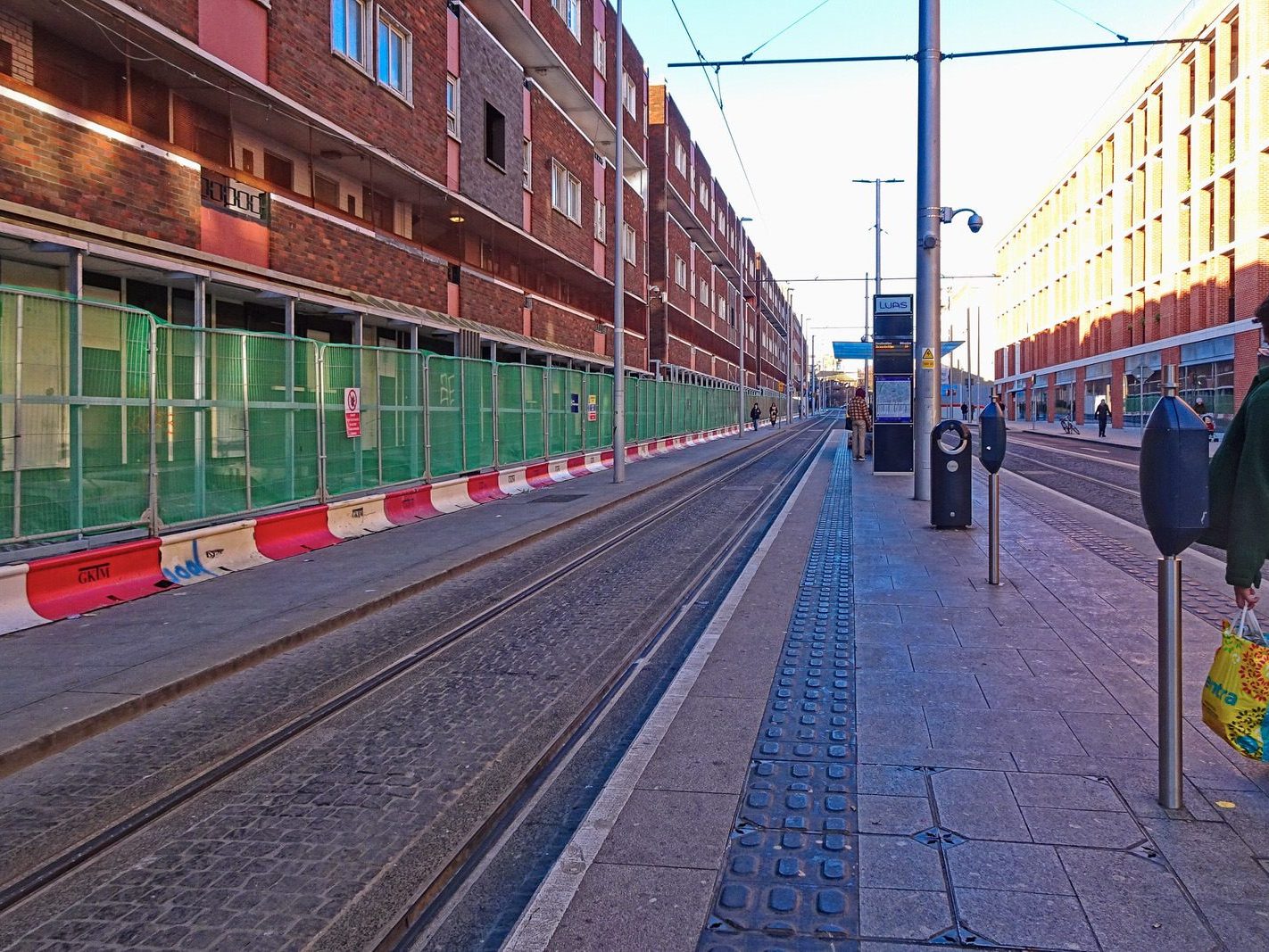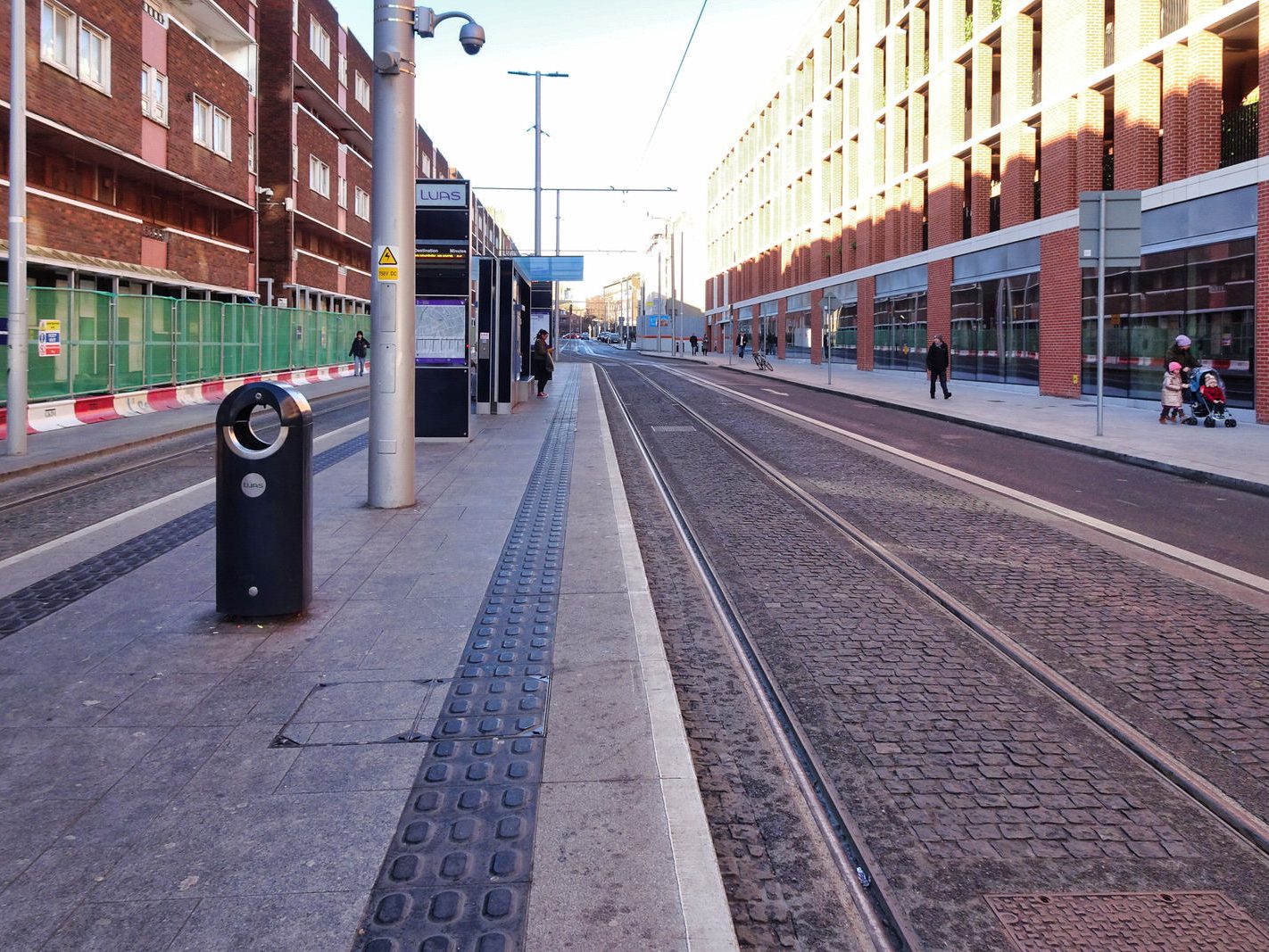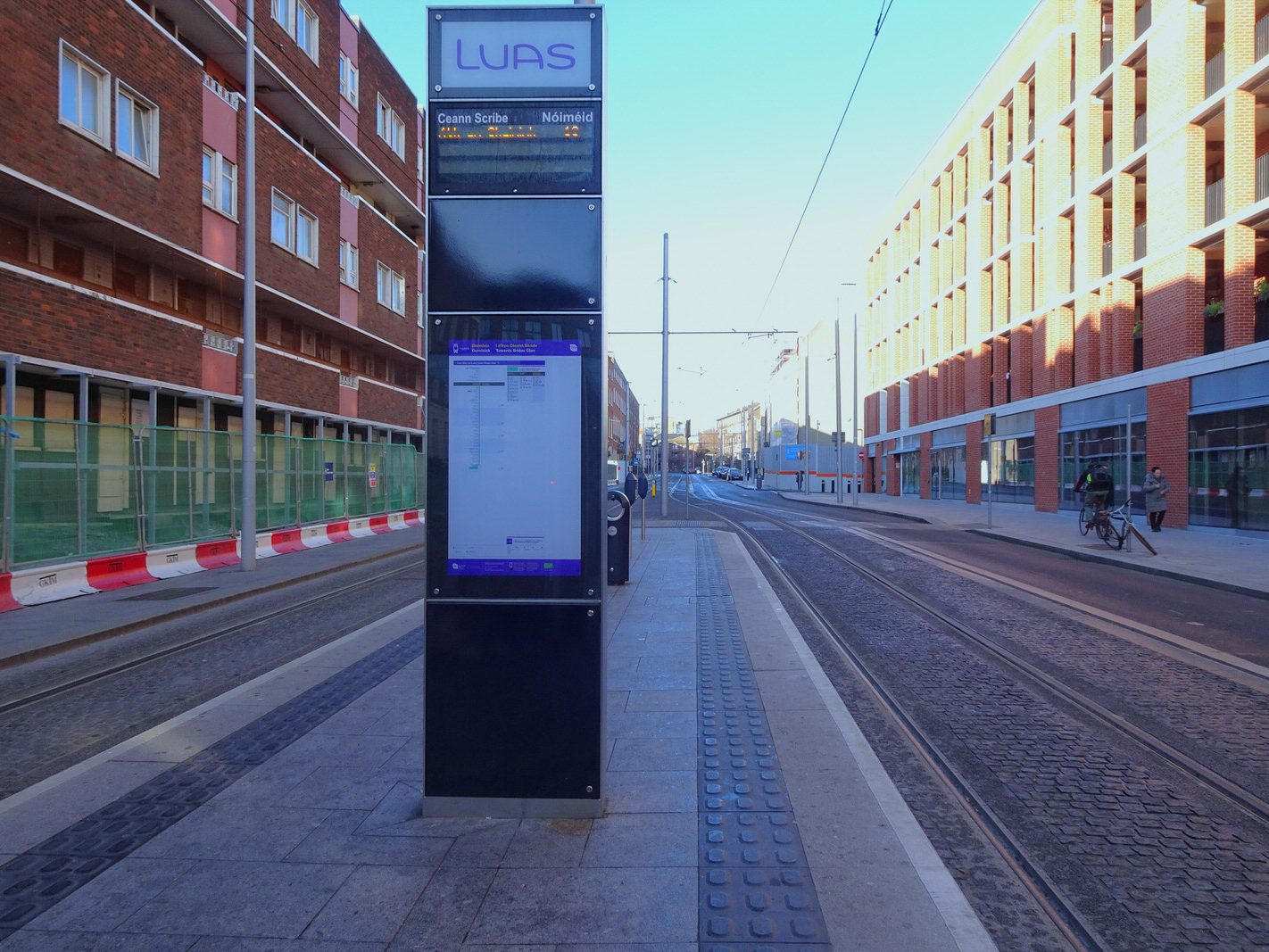OF COURSE BAGGOT IS NOT ON THE NORTH SIDE OF THE CITY
Baggot street runs from Merrion Row (near St. Stephen’s Green) to the northwestern end of Pembroke Road. It crosses the Grand Canal near Haddington Road. It is divided into two sections:
Lower Baggot Street – between Merrion Row and the Grand Canal. It was called Gallows Road in the 18th century.
Upper Baggot Street – south of the Grand Canal until the junction with Eastmoreland Place, where it continues as Pembroke Road.
Lower Baggot Street is distinguished by Georgian architecture, while Upper Baggot Street has mainly Victorian architecture with a few buildings of 20th century vintage. The Royal City of Dublin Hospital, Baggot Street, opened in 1834, is on the east side of Upper Baggot Street, just south of the junction with Haddington Road. Cook’s Map of 1836 shows the north side of Upper Baggot Street and Pembroke Road almost entirely built on.
The Sheares Brothers, members of the Society of United Irishmen, who died in the 1798 rebellion, lived at no. 128.
In 1830, Thomas Davis, the revolutionary Irish writer who was the chief organiser and poet of the Young Ireland movement, lived at 67 Lower Baggot Street.
Catherine McAuley, a nun, founded the Sisters of Mercy order in 1831 and built what is now the Mercy International Centre on Lower Baggot Street where she later died in 1841.
In 1909, Francis Bacon was born at 63 Lower Baggot Street.
The poet Patrick Kavanagh frequented Baggot Street and regarded it as his favourite place in Dublin. In his poem “If ever you go to Dublin Town” Kavanagh addresses Dubliners 100 years after his own time and tells them to “Inquire for me in Baggot Street/And what I was like to know”.
Singer-songwriter Sinéad O’Connor had a property here.
![BAGGOT STREET WAS HOME TO SOME INTERESTING PEOPLE [11 FEBRUARY 2024]-228064-1](https://excellentstreetimages.com/NorthOfTheRiverWordPress/wp-content/uploads/2024/02/BAGGOT-STREET-WAS-HOME-TO-SOME-INTERESTING-PEOPLE-11-FEBRUARY-2024-228064-1-150x150.jpg)
![BAGGOT STREET WAS HOME TO SOME INTERESTING PEOPLE [11 FEBRUARY 2024]-228052-1 BAGGOT STREET WAS HOME TO SOME INTERESTING PEOPLE [11 FEBRUARY 2024]-228052-1](https://excellentstreetimages.com/NorthOfTheRiverWordPress/wp-content/uploads/2024/02/BAGGOT-STREET-WAS-HOME-TO-SOME-INTERESTING-PEOPLE-11-FEBRUARY-2024-228052-1-1422x1067.jpg)
![BAGGOT STREET WAS HOME TO SOME INTERESTING PEOPLE [11 FEBRUARY 2024]-228055-1 BAGGOT STREET WAS HOME TO SOME INTERESTING PEOPLE [11 FEBRUARY 2024]-228055-1](https://excellentstreetimages.com/NorthOfTheRiverWordPress/wp-content/uploads/2024/02/BAGGOT-STREET-WAS-HOME-TO-SOME-INTERESTING-PEOPLE-11-FEBRUARY-2024-228055-1-1422x1067.jpg)
![BAGGOT STREET WAS HOME TO SOME INTERESTING PEOPLE [11 FEBRUARY 2024]-228053-1 BAGGOT STREET WAS HOME TO SOME INTERESTING PEOPLE [11 FEBRUARY 2024]-228053-1](https://excellentstreetimages.com/NorthOfTheRiverWordPress/wp-content/uploads/2024/02/BAGGOT-STREET-WAS-HOME-TO-SOME-INTERESTING-PEOPLE-11-FEBRUARY-2024-228053-1-1422x1067.jpg)
![BAGGOT STREET WAS HOME TO SOME INTERESTING PEOPLE [11 FEBRUARY 2024]-228056-1 BAGGOT STREET WAS HOME TO SOME INTERESTING PEOPLE [11 FEBRUARY 2024]-228056-1](https://excellentstreetimages.com/NorthOfTheRiverWordPress/wp-content/uploads/2024/02/BAGGOT-STREET-WAS-HOME-TO-SOME-INTERESTING-PEOPLE-11-FEBRUARY-2024-228056-1-1422x1067.jpg)
![BAGGOT STREET WAS HOME TO SOME INTERESTING PEOPLE [11 FEBRUARY 2024]-228057-1 BAGGOT STREET WAS HOME TO SOME INTERESTING PEOPLE [11 FEBRUARY 2024]-228057-1](https://excellentstreetimages.com/NorthOfTheRiverWordPress/wp-content/uploads/2024/02/BAGGOT-STREET-WAS-HOME-TO-SOME-INTERESTING-PEOPLE-11-FEBRUARY-2024-228057-1-1422x1067.jpg)
![BAGGOT STREET WAS HOME TO SOME INTERESTING PEOPLE [11 FEBRUARY 2024]-228058-1 BAGGOT STREET WAS HOME TO SOME INTERESTING PEOPLE [11 FEBRUARY 2024]-228058-1](https://excellentstreetimages.com/NorthOfTheRiverWordPress/wp-content/uploads/2024/02/BAGGOT-STREET-WAS-HOME-TO-SOME-INTERESTING-PEOPLE-11-FEBRUARY-2024-228058-1-1422x1067.jpg)
![BAGGOT STREET WAS HOME TO SOME INTERESTING PEOPLE [11 FEBRUARY 2024]-228059-1 BAGGOT STREET WAS HOME TO SOME INTERESTING PEOPLE [11 FEBRUARY 2024]-228059-1](https://excellentstreetimages.com/NorthOfTheRiverWordPress/wp-content/uploads/2024/02/BAGGOT-STREET-WAS-HOME-TO-SOME-INTERESTING-PEOPLE-11-FEBRUARY-2024-228059-1-1422x1067.jpg)
![BAGGOT STREET WAS HOME TO SOME INTERESTING PEOPLE [11 FEBRUARY 2024]-228054-1 BAGGOT STREET WAS HOME TO SOME INTERESTING PEOPLE [11 FEBRUARY 2024]-228054-1](https://excellentstreetimages.com/NorthOfTheRiverWordPress/wp-content/uploads/2024/02/BAGGOT-STREET-WAS-HOME-TO-SOME-INTERESTING-PEOPLE-11-FEBRUARY-2024-228054-1-1422x1067.jpg)
![BAGGOT STREET WAS HOME TO SOME INTERESTING PEOPLE [11 FEBRUARY 2024]-228061-1 BAGGOT STREET WAS HOME TO SOME INTERESTING PEOPLE [11 FEBRUARY 2024]-228061-1](https://excellentstreetimages.com/NorthOfTheRiverWordPress/wp-content/uploads/2024/02/BAGGOT-STREET-WAS-HOME-TO-SOME-INTERESTING-PEOPLE-11-FEBRUARY-2024-228061-1-1422x1067.jpg)
![BAGGOT STREET WAS HOME TO SOME INTERESTING PEOPLE [11 FEBRUARY 2024]-228060-1 BAGGOT STREET WAS HOME TO SOME INTERESTING PEOPLE [11 FEBRUARY 2024]-228060-1](https://excellentstreetimages.com/NorthOfTheRiverWordPress/wp-content/uploads/2024/02/BAGGOT-STREET-WAS-HOME-TO-SOME-INTERESTING-PEOPLE-11-FEBRUARY-2024-228060-1-1422x1067.jpg)
![BAGGOT STREET WAS HOME TO SOME INTERESTING PEOPLE [11 FEBRUARY 2024]-228062-1 BAGGOT STREET WAS HOME TO SOME INTERESTING PEOPLE [11 FEBRUARY 2024]-228062-1](https://excellentstreetimages.com/NorthOfTheRiverWordPress/wp-content/uploads/2024/02/BAGGOT-STREET-WAS-HOME-TO-SOME-INTERESTING-PEOPLE-11-FEBRUARY-2024-228062-1-1422x1067.jpg)
![BAGGOT STREET WAS HOME TO SOME INTERESTING PEOPLE [11 FEBRUARY 2024]-228064-1 BAGGOT STREET WAS HOME TO SOME INTERESTING PEOPLE [11 FEBRUARY 2024]-228064-1](https://excellentstreetimages.com/NorthOfTheRiverWordPress/wp-content/uploads/2024/02/BAGGOT-STREET-WAS-HOME-TO-SOME-INTERESTING-PEOPLE-11-FEBRUARY-2024-228064-1-1422x1067.jpg)
![BAGGOT STREET WAS HOME TO SOME INTERESTING PEOPLE [11 FEBRUARY 2024]-228063-1 BAGGOT STREET WAS HOME TO SOME INTERESTING PEOPLE [11 FEBRUARY 2024]-228063-1](https://excellentstreetimages.com/NorthOfTheRiverWordPress/wp-content/uploads/2024/02/BAGGOT-STREET-WAS-HOME-TO-SOME-INTERESTING-PEOPLE-11-FEBRUARY-2024-228063-1-1422x1067.jpg)
![BAGGOT STREET WAS HOME TO SOME INTERESTING PEOPLE [11 FEBRUARY 2024]-228065-1 BAGGOT STREET WAS HOME TO SOME INTERESTING PEOPLE [11 FEBRUARY 2024]-228065-1](https://excellentstreetimages.com/NorthOfTheRiverWordPress/wp-content/uploads/2024/02/BAGGOT-STREET-WAS-HOME-TO-SOME-INTERESTING-PEOPLE-11-FEBRUARY-2024-228065-1-1422x1067.jpg)
![BAGGOT STREET WAS HOME TO SOME INTERESTING PEOPLE [11 FEBRUARY 2024]-228067-1 BAGGOT STREET WAS HOME TO SOME INTERESTING PEOPLE [11 FEBRUARY 2024]-228067-1](https://excellentstreetimages.com/NorthOfTheRiverWordPress/wp-content/uploads/2024/02/BAGGOT-STREET-WAS-HOME-TO-SOME-INTERESTING-PEOPLE-11-FEBRUARY-2024-228067-1-1422x1067.jpg)
![BAGGOT STREET WAS HOME TO SOME INTERESTING PEOPLE [11 FEBRUARY 2024]-228068-1 BAGGOT STREET WAS HOME TO SOME INTERESTING PEOPLE [11 FEBRUARY 2024]-228068-1](https://excellentstreetimages.com/NorthOfTheRiverWordPress/wp-content/uploads/2024/02/BAGGOT-STREET-WAS-HOME-TO-SOME-INTERESTING-PEOPLE-11-FEBRUARY-2024-228068-1-1422x1067.jpg)
![BAGGOT STREET WAS HOME TO SOME INTERESTING PEOPLE [11 FEBRUARY 2024]-228066-1 BAGGOT STREET WAS HOME TO SOME INTERESTING PEOPLE [11 FEBRUARY 2024]-228066-1](https://excellentstreetimages.com/NorthOfTheRiverWordPress/wp-content/uploads/2024/02/BAGGOT-STREET-WAS-HOME-TO-SOME-INTERESTING-PEOPLE-11-FEBRUARY-2024-228066-1-1422x1067.jpg)
![BAGGOT STREET WAS HOME TO SOME INTERESTING PEOPLE [11 FEBRUARY 2024]-228069-1 BAGGOT STREET WAS HOME TO SOME INTERESTING PEOPLE [11 FEBRUARY 2024]-228069-1](https://excellentstreetimages.com/NorthOfTheRiverWordPress/wp-content/uploads/2024/02/BAGGOT-STREET-WAS-HOME-TO-SOME-INTERESTING-PEOPLE-11-FEBRUARY-2024-228069-1-1422x1067.jpg)
![BAGGOT STREET WAS HOME TO SOME INTERESTING PEOPLE [11 FEBRUARY 2024]-228070-1 BAGGOT STREET WAS HOME TO SOME INTERESTING PEOPLE [11 FEBRUARY 2024]-228070-1](https://excellentstreetimages.com/NorthOfTheRiverWordPress/wp-content/uploads/2024/02/BAGGOT-STREET-WAS-HOME-TO-SOME-INTERESTING-PEOPLE-11-FEBRUARY-2024-228070-1-1422x1067.jpg)





![I VISITED THE GRANGEGORMAN UNIVERSITY CAMPUS [THERE WAS NO SIGN OF CHRISTMAS CELEBRATIONS THERE]-226044-1](https://excellentstreetimages.com/NorthOfTheRiverWordPress/wp-content/uploads/2023/12/I-VISITED-THE-GRANGEGORMAN-UNIVERSITY-CAMPUS-THERE-WAS-NO-SIGN-OF-CHRISTMAS-CELEBRATIONS-THERE-226044-1-150x150.jpg)
![I VISITED THE GRANGEGORMAN UNIVERSITY CAMPUS [THERE WAS NO SIGN OF CHRISTMAS CELEBRATIONS THERE]-226027-1 I VISITED THE GRANGEGORMAN UNIVERSITY CAMPUS [THERE WAS NO SIGN OF CHRISTMAS CELEBRATIONS THERE]-226027-1](https://excellentstreetimages.com/NorthOfTheRiverWordPress/wp-content/uploads/2023/12/I-VISITED-THE-GRANGEGORMAN-UNIVERSITY-CAMPUS-THERE-WAS-NO-SIGN-OF-CHRISTMAS-CELEBRATIONS-THERE-226027-1-1422x1067.jpg)
![I VISITED THE GRANGEGORMAN UNIVERSITY CAMPUS [THERE WAS NO SIGN OF CHRISTMAS CELEBRATIONS THERE]-226030-1 I VISITED THE GRANGEGORMAN UNIVERSITY CAMPUS [THERE WAS NO SIGN OF CHRISTMAS CELEBRATIONS THERE]-226030-1](https://excellentstreetimages.com/NorthOfTheRiverWordPress/wp-content/uploads/2023/12/I-VISITED-THE-GRANGEGORMAN-UNIVERSITY-CAMPUS-THERE-WAS-NO-SIGN-OF-CHRISTMAS-CELEBRATIONS-THERE-226030-1-1422x1067.jpg)
![I VISITED THE GRANGEGORMAN UNIVERSITY CAMPUS [THERE WAS NO SIGN OF CHRISTMAS CELEBRATIONS THERE]-226029-1 I VISITED THE GRANGEGORMAN UNIVERSITY CAMPUS [THERE WAS NO SIGN OF CHRISTMAS CELEBRATIONS THERE]-226029-1](https://excellentstreetimages.com/NorthOfTheRiverWordPress/wp-content/uploads/2023/12/I-VISITED-THE-GRANGEGORMAN-UNIVERSITY-CAMPUS-THERE-WAS-NO-SIGN-OF-CHRISTMAS-CELEBRATIONS-THERE-226029-1-1422x1067.jpg)
![I VISITED THE GRANGEGORMAN UNIVERSITY CAMPUS [THERE WAS NO SIGN OF CHRISTMAS CELEBRATIONS THERE]-226028-1 I VISITED THE GRANGEGORMAN UNIVERSITY CAMPUS [THERE WAS NO SIGN OF CHRISTMAS CELEBRATIONS THERE]-226028-1](https://excellentstreetimages.com/NorthOfTheRiverWordPress/wp-content/uploads/2023/12/I-VISITED-THE-GRANGEGORMAN-UNIVERSITY-CAMPUS-THERE-WAS-NO-SIGN-OF-CHRISTMAS-CELEBRATIONS-THERE-226028-1-1422x1067.jpg)
![I VISITED THE GRANGEGORMAN UNIVERSITY CAMPUS [THERE WAS NO SIGN OF CHRISTMAS CELEBRATIONS THERE]-226031-1 I VISITED THE GRANGEGORMAN UNIVERSITY CAMPUS [THERE WAS NO SIGN OF CHRISTMAS CELEBRATIONS THERE]-226031-1](https://excellentstreetimages.com/NorthOfTheRiverWordPress/wp-content/uploads/2023/12/I-VISITED-THE-GRANGEGORMAN-UNIVERSITY-CAMPUS-THERE-WAS-NO-SIGN-OF-CHRISTMAS-CELEBRATIONS-THERE-226031-1-1422x1067.jpg)
![I VISITED THE GRANGEGORMAN UNIVERSITY CAMPUS [THERE WAS NO SIGN OF CHRISTMAS CELEBRATIONS THERE]-226034-1 I VISITED THE GRANGEGORMAN UNIVERSITY CAMPUS [THERE WAS NO SIGN OF CHRISTMAS CELEBRATIONS THERE]-226034-1](https://excellentstreetimages.com/NorthOfTheRiverWordPress/wp-content/uploads/2023/12/I-VISITED-THE-GRANGEGORMAN-UNIVERSITY-CAMPUS-THERE-WAS-NO-SIGN-OF-CHRISTMAS-CELEBRATIONS-THERE-226034-1-1422x1067.jpg)
![I VISITED THE GRANGEGORMAN UNIVERSITY CAMPUS [THERE WAS NO SIGN OF CHRISTMAS CELEBRATIONS THERE]-226033-1 I VISITED THE GRANGEGORMAN UNIVERSITY CAMPUS [THERE WAS NO SIGN OF CHRISTMAS CELEBRATIONS THERE]-226033-1](https://excellentstreetimages.com/NorthOfTheRiverWordPress/wp-content/uploads/2023/12/I-VISITED-THE-GRANGEGORMAN-UNIVERSITY-CAMPUS-THERE-WAS-NO-SIGN-OF-CHRISTMAS-CELEBRATIONS-THERE-226033-1-1422x1067.jpg)
![I VISITED THE GRANGEGORMAN UNIVERSITY CAMPUS [THERE WAS NO SIGN OF CHRISTMAS CELEBRATIONS THERE]-226032-1 I VISITED THE GRANGEGORMAN UNIVERSITY CAMPUS [THERE WAS NO SIGN OF CHRISTMAS CELEBRATIONS THERE]-226032-1](https://excellentstreetimages.com/NorthOfTheRiverWordPress/wp-content/uploads/2023/12/I-VISITED-THE-GRANGEGORMAN-UNIVERSITY-CAMPUS-THERE-WAS-NO-SIGN-OF-CHRISTMAS-CELEBRATIONS-THERE-226032-1-1422x1067.jpg)
![I VISITED THE GRANGEGORMAN UNIVERSITY CAMPUS [THERE WAS NO SIGN OF CHRISTMAS CELEBRATIONS THERE]-226036-1 I VISITED THE GRANGEGORMAN UNIVERSITY CAMPUS [THERE WAS NO SIGN OF CHRISTMAS CELEBRATIONS THERE]-226036-1](https://excellentstreetimages.com/NorthOfTheRiverWordPress/wp-content/uploads/2023/12/I-VISITED-THE-GRANGEGORMAN-UNIVERSITY-CAMPUS-THERE-WAS-NO-SIGN-OF-CHRISTMAS-CELEBRATIONS-THERE-226036-1-1422x1067.jpg)
![I VISITED THE GRANGEGORMAN UNIVERSITY CAMPUS [THERE WAS NO SIGN OF CHRISTMAS CELEBRATIONS THERE]-226035-1 I VISITED THE GRANGEGORMAN UNIVERSITY CAMPUS [THERE WAS NO SIGN OF CHRISTMAS CELEBRATIONS THERE]-226035-1](https://excellentstreetimages.com/NorthOfTheRiverWordPress/wp-content/uploads/2023/12/I-VISITED-THE-GRANGEGORMAN-UNIVERSITY-CAMPUS-THERE-WAS-NO-SIGN-OF-CHRISTMAS-CELEBRATIONS-THERE-226035-1-1422x1067.jpg)
![I VISITED THE GRANGEGORMAN UNIVERSITY CAMPUS [THERE WAS NO SIGN OF CHRISTMAS CELEBRATIONS THERE]-226040-1 I VISITED THE GRANGEGORMAN UNIVERSITY CAMPUS [THERE WAS NO SIGN OF CHRISTMAS CELEBRATIONS THERE]-226040-1](https://excellentstreetimages.com/NorthOfTheRiverWordPress/wp-content/uploads/2023/12/I-VISITED-THE-GRANGEGORMAN-UNIVERSITY-CAMPUS-THERE-WAS-NO-SIGN-OF-CHRISTMAS-CELEBRATIONS-THERE-226040-1-1422x1067.jpg)
![I VISITED THE GRANGEGORMAN UNIVERSITY CAMPUS [THERE WAS NO SIGN OF CHRISTMAS CELEBRATIONS THERE]-226039-1 I VISITED THE GRANGEGORMAN UNIVERSITY CAMPUS [THERE WAS NO SIGN OF CHRISTMAS CELEBRATIONS THERE]-226039-1](https://excellentstreetimages.com/NorthOfTheRiverWordPress/wp-content/uploads/2023/12/I-VISITED-THE-GRANGEGORMAN-UNIVERSITY-CAMPUS-THERE-WAS-NO-SIGN-OF-CHRISTMAS-CELEBRATIONS-THERE-226039-1-1422x1067.jpg)
![I VISITED THE GRANGEGORMAN UNIVERSITY CAMPUS [THERE WAS NO SIGN OF CHRISTMAS CELEBRATIONS THERE]-226038-1 I VISITED THE GRANGEGORMAN UNIVERSITY CAMPUS [THERE WAS NO SIGN OF CHRISTMAS CELEBRATIONS THERE]-226038-1](https://excellentstreetimages.com/NorthOfTheRiverWordPress/wp-content/uploads/2023/12/I-VISITED-THE-GRANGEGORMAN-UNIVERSITY-CAMPUS-THERE-WAS-NO-SIGN-OF-CHRISTMAS-CELEBRATIONS-THERE-226038-1-1422x1067.jpg)
![I VISITED THE GRANGEGORMAN UNIVERSITY CAMPUS [THERE WAS NO SIGN OF CHRISTMAS CELEBRATIONS THERE]-226037-1 I VISITED THE GRANGEGORMAN UNIVERSITY CAMPUS [THERE WAS NO SIGN OF CHRISTMAS CELEBRATIONS THERE]-226037-1](https://excellentstreetimages.com/NorthOfTheRiverWordPress/wp-content/uploads/2023/12/I-VISITED-THE-GRANGEGORMAN-UNIVERSITY-CAMPUS-THERE-WAS-NO-SIGN-OF-CHRISTMAS-CELEBRATIONS-THERE-226037-1-1422x1067.jpg)
![I VISITED THE GRANGEGORMAN UNIVERSITY CAMPUS [THERE WAS NO SIGN OF CHRISTMAS CELEBRATIONS THERE]-226043-1 I VISITED THE GRANGEGORMAN UNIVERSITY CAMPUS [THERE WAS NO SIGN OF CHRISTMAS CELEBRATIONS THERE]-226043-1](https://excellentstreetimages.com/NorthOfTheRiverWordPress/wp-content/uploads/2023/12/I-VISITED-THE-GRANGEGORMAN-UNIVERSITY-CAMPUS-THERE-WAS-NO-SIGN-OF-CHRISTMAS-CELEBRATIONS-THERE-226043-1-1422x1067.jpg)
![I VISITED THE GRANGEGORMAN UNIVERSITY CAMPUS [THERE WAS NO SIGN OF CHRISTMAS CELEBRATIONS THERE]-226042-1 I VISITED THE GRANGEGORMAN UNIVERSITY CAMPUS [THERE WAS NO SIGN OF CHRISTMAS CELEBRATIONS THERE]-226042-1](https://excellentstreetimages.com/NorthOfTheRiverWordPress/wp-content/uploads/2023/12/I-VISITED-THE-GRANGEGORMAN-UNIVERSITY-CAMPUS-THERE-WAS-NO-SIGN-OF-CHRISTMAS-CELEBRATIONS-THERE-226042-1-1422x1067.jpg)
![I VISITED THE GRANGEGORMAN UNIVERSITY CAMPUS [THERE WAS NO SIGN OF CHRISTMAS CELEBRATIONS THERE]-226041-1 I VISITED THE GRANGEGORMAN UNIVERSITY CAMPUS [THERE WAS NO SIGN OF CHRISTMAS CELEBRATIONS THERE]-226041-1](https://excellentstreetimages.com/NorthOfTheRiverWordPress/wp-content/uploads/2023/12/I-VISITED-THE-GRANGEGORMAN-UNIVERSITY-CAMPUS-THERE-WAS-NO-SIGN-OF-CHRISTMAS-CELEBRATIONS-THERE-226041-1-1422x1067.jpg)
![I VISITED THE GRANGEGORMAN UNIVERSITY CAMPUS [THERE WAS NO SIGN OF CHRISTMAS CELEBRATIONS THERE]-226045-1 I VISITED THE GRANGEGORMAN UNIVERSITY CAMPUS [THERE WAS NO SIGN OF CHRISTMAS CELEBRATIONS THERE]-226045-1](https://excellentstreetimages.com/NorthOfTheRiverWordPress/wp-content/uploads/2023/12/I-VISITED-THE-GRANGEGORMAN-UNIVERSITY-CAMPUS-THERE-WAS-NO-SIGN-OF-CHRISTMAS-CELEBRATIONS-THERE-226045-1-1422x1067.jpg)
![I VISITED THE GRANGEGORMAN UNIVERSITY CAMPUS [THERE WAS NO SIGN OF CHRISTMAS CELEBRATIONS THERE]-226044-1 I VISITED THE GRANGEGORMAN UNIVERSITY CAMPUS [THERE WAS NO SIGN OF CHRISTMAS CELEBRATIONS THERE]-226044-1](https://excellentstreetimages.com/NorthOfTheRiverWordPress/wp-content/uploads/2023/12/I-VISITED-THE-GRANGEGORMAN-UNIVERSITY-CAMPUS-THERE-WAS-NO-SIGN-OF-CHRISTMAS-CELEBRATIONS-THERE-226044-1-1422x1067.jpg)
![I VISITED THE GRANGEGORMAN UNIVERSITY CAMPUS [THERE WAS NO SIGN OF CHRISTMAS CELEBRATIONS THERE]-226046-1 I VISITED THE GRANGEGORMAN UNIVERSITY CAMPUS [THERE WAS NO SIGN OF CHRISTMAS CELEBRATIONS THERE]-226046-1](https://excellentstreetimages.com/NorthOfTheRiverWordPress/wp-content/uploads/2023/12/I-VISITED-THE-GRANGEGORMAN-UNIVERSITY-CAMPUS-THERE-WAS-NO-SIGN-OF-CHRISTMAS-CELEBRATIONS-THERE-226046-1-1422x1067.jpg)
![I VISITED THE GRANGEGORMAN UNIVERSITY CAMPUS [THERE WAS NO SIGN OF CHRISTMAS CELEBRATIONS THERE]-226048-1 I VISITED THE GRANGEGORMAN UNIVERSITY CAMPUS [THERE WAS NO SIGN OF CHRISTMAS CELEBRATIONS THERE]-226048-1](https://excellentstreetimages.com/NorthOfTheRiverWordPress/wp-content/uploads/2023/12/I-VISITED-THE-GRANGEGORMAN-UNIVERSITY-CAMPUS-THERE-WAS-NO-SIGN-OF-CHRISTMAS-CELEBRATIONS-THERE-226048-1-1422x1067.jpg)
![I VISITED THE GRANGEGORMAN UNIVERSITY CAMPUS [THERE WAS NO SIGN OF CHRISTMAS CELEBRATIONS THERE]-226047-1 I VISITED THE GRANGEGORMAN UNIVERSITY CAMPUS [THERE WAS NO SIGN OF CHRISTMAS CELEBRATIONS THERE]-226047-1](https://excellentstreetimages.com/NorthOfTheRiverWordPress/wp-content/uploads/2023/12/I-VISITED-THE-GRANGEGORMAN-UNIVERSITY-CAMPUS-THERE-WAS-NO-SIGN-OF-CHRISTMAS-CELEBRATIONS-THERE-226047-1-1422x1067.jpg)
![I VISITED THE GRANGEGORMAN UNIVERSITY CAMPUS [THERE WAS NO SIGN OF CHRISTMAS CELEBRATIONS THERE]-226050-1 I VISITED THE GRANGEGORMAN UNIVERSITY CAMPUS [THERE WAS NO SIGN OF CHRISTMAS CELEBRATIONS THERE]-226050-1](https://excellentstreetimages.com/NorthOfTheRiverWordPress/wp-content/uploads/2023/12/I-VISITED-THE-GRANGEGORMAN-UNIVERSITY-CAMPUS-THERE-WAS-NO-SIGN-OF-CHRISTMAS-CELEBRATIONS-THERE-226050-1-1422x1067.jpg)
![I VISITED THE GRANGEGORMAN UNIVERSITY CAMPUS [THERE WAS NO SIGN OF CHRISTMAS CELEBRATIONS THERE]-226049-1 I VISITED THE GRANGEGORMAN UNIVERSITY CAMPUS [THERE WAS NO SIGN OF CHRISTMAS CELEBRATIONS THERE]-226049-1](https://excellentstreetimages.com/NorthOfTheRiverWordPress/wp-content/uploads/2023/12/I-VISITED-THE-GRANGEGORMAN-UNIVERSITY-CAMPUS-THERE-WAS-NO-SIGN-OF-CHRISTMAS-CELEBRATIONS-THERE-226049-1-1422x1067.jpg)
![I VISITED THE GRANGEGORMAN UNIVERSITY CAMPUS [THERE WAS NO SIGN OF CHRISTMAS CELEBRATIONS THERE]-226052-1 I VISITED THE GRANGEGORMAN UNIVERSITY CAMPUS [THERE WAS NO SIGN OF CHRISTMAS CELEBRATIONS THERE]-226052-1](https://excellentstreetimages.com/NorthOfTheRiverWordPress/wp-content/uploads/2023/12/I-VISITED-THE-GRANGEGORMAN-UNIVERSITY-CAMPUS-THERE-WAS-NO-SIGN-OF-CHRISTMAS-CELEBRATIONS-THERE-226052-1-1422x1067.jpg)
![I VISITED THE GRANGEGORMAN UNIVERSITY CAMPUS [THERE WAS NO SIGN OF CHRISTMAS CELEBRATIONS THERE]-226051-1 I VISITED THE GRANGEGORMAN UNIVERSITY CAMPUS [THERE WAS NO SIGN OF CHRISTMAS CELEBRATIONS THERE]-226051-1](https://excellentstreetimages.com/NorthOfTheRiverWordPress/wp-content/uploads/2023/12/I-VISITED-THE-GRANGEGORMAN-UNIVERSITY-CAMPUS-THERE-WAS-NO-SIGN-OF-CHRISTMAS-CELEBRATIONS-THERE-226051-1-1422x1067.jpg)
![I VISITED THE GRANGEGORMAN UNIVERSITY CAMPUS [THERE WAS NO SIGN OF CHRISTMAS CELEBRATIONS THERE]-226054-1 I VISITED THE GRANGEGORMAN UNIVERSITY CAMPUS [THERE WAS NO SIGN OF CHRISTMAS CELEBRATIONS THERE]-226054-1](https://excellentstreetimages.com/NorthOfTheRiverWordPress/wp-content/uploads/2023/12/I-VISITED-THE-GRANGEGORMAN-UNIVERSITY-CAMPUS-THERE-WAS-NO-SIGN-OF-CHRISTMAS-CELEBRATIONS-THERE-226054-1-1422x1067.jpg)
![I VISITED THE GRANGEGORMAN UNIVERSITY CAMPUS [THERE WAS NO SIGN OF CHRISTMAS CELEBRATIONS THERE]-226053-1 I VISITED THE GRANGEGORMAN UNIVERSITY CAMPUS [THERE WAS NO SIGN OF CHRISTMAS CELEBRATIONS THERE]-226053-1](https://excellentstreetimages.com/NorthOfTheRiverWordPress/wp-content/uploads/2023/12/I-VISITED-THE-GRANGEGORMAN-UNIVERSITY-CAMPUS-THERE-WAS-NO-SIGN-OF-CHRISTMAS-CELEBRATIONS-THERE-226053-1-1422x1067.jpg)
![I VISITED THE GRANGEGORMAN UNIVERSITY CAMPUS [THERE WAS NO SIGN OF CHRISTMAS CELEBRATIONS THERE]-226055-1 I VISITED THE GRANGEGORMAN UNIVERSITY CAMPUS [THERE WAS NO SIGN OF CHRISTMAS CELEBRATIONS THERE]-226055-1](https://excellentstreetimages.com/NorthOfTheRiverWordPress/wp-content/uploads/2023/12/I-VISITED-THE-GRANGEGORMAN-UNIVERSITY-CAMPUS-THERE-WAS-NO-SIGN-OF-CHRISTMAS-CELEBRATIONS-THERE-226055-1-1422x1067.jpg)
![I VISITED THE GRANGEGORMAN UNIVERSITY CAMPUS [THERE WAS NO SIGN OF CHRISTMAS CELEBRATIONS THERE]-226056-1 I VISITED THE GRANGEGORMAN UNIVERSITY CAMPUS [THERE WAS NO SIGN OF CHRISTMAS CELEBRATIONS THERE]-226056-1](https://excellentstreetimages.com/NorthOfTheRiverWordPress/wp-content/uploads/2023/12/I-VISITED-THE-GRANGEGORMAN-UNIVERSITY-CAMPUS-THERE-WAS-NO-SIGN-OF-CHRISTMAS-CELEBRATIONS-THERE-226056-1-1422x1067.jpg)
![I VISITED THE GRANGEGORMAN UNIVERSITY CAMPUS [THERE WAS NO SIGN OF CHRISTMAS CELEBRATIONS THERE]-226058-1 I VISITED THE GRANGEGORMAN UNIVERSITY CAMPUS [THERE WAS NO SIGN OF CHRISTMAS CELEBRATIONS THERE]-226058-1](https://excellentstreetimages.com/NorthOfTheRiverWordPress/wp-content/uploads/2023/12/I-VISITED-THE-GRANGEGORMAN-UNIVERSITY-CAMPUS-THERE-WAS-NO-SIGN-OF-CHRISTMAS-CELEBRATIONS-THERE-226058-1-1422x1067.jpg)
![I VISITED THE GRANGEGORMAN UNIVERSITY CAMPUS [THERE WAS NO SIGN OF CHRISTMAS CELEBRATIONS THERE]-226057-1 I VISITED THE GRANGEGORMAN UNIVERSITY CAMPUS [THERE WAS NO SIGN OF CHRISTMAS CELEBRATIONS THERE]-226057-1](https://excellentstreetimages.com/NorthOfTheRiverWordPress/wp-content/uploads/2023/12/I-VISITED-THE-GRANGEGORMAN-UNIVERSITY-CAMPUS-THERE-WAS-NO-SIGN-OF-CHRISTMAS-CELEBRATIONS-THERE-226057-1-1422x1067.jpg)
![I VISITED THE GRANGEGORMAN UNIVERSITY CAMPUS [THERE WAS NO SIGN OF CHRISTMAS CELEBRATIONS THERE]-226060-1 I VISITED THE GRANGEGORMAN UNIVERSITY CAMPUS [THERE WAS NO SIGN OF CHRISTMAS CELEBRATIONS THERE]-226060-1](https://excellentstreetimages.com/NorthOfTheRiverWordPress/wp-content/uploads/2023/12/I-VISITED-THE-GRANGEGORMAN-UNIVERSITY-CAMPUS-THERE-WAS-NO-SIGN-OF-CHRISTMAS-CELEBRATIONS-THERE-226060-1-1422x1067.jpg)
![I VISITED THE GRANGEGORMAN UNIVERSITY CAMPUS [THERE WAS NO SIGN OF CHRISTMAS CELEBRATIONS THERE]-226059-1 I VISITED THE GRANGEGORMAN UNIVERSITY CAMPUS [THERE WAS NO SIGN OF CHRISTMAS CELEBRATIONS THERE]-226059-1](https://excellentstreetimages.com/NorthOfTheRiverWordPress/wp-content/uploads/2023/12/I-VISITED-THE-GRANGEGORMAN-UNIVERSITY-CAMPUS-THERE-WAS-NO-SIGN-OF-CHRISTMAS-CELEBRATIONS-THERE-226059-1-1422x1067.jpg)
![I VISITED THE GRANGEGORMAN UNIVERSITY CAMPUS [THERE WAS NO SIGN OF CHRISTMAS CELEBRATIONS THERE]-226061-1 I VISITED THE GRANGEGORMAN UNIVERSITY CAMPUS [THERE WAS NO SIGN OF CHRISTMAS CELEBRATIONS THERE]-226061-1](https://excellentstreetimages.com/NorthOfTheRiverWordPress/wp-content/uploads/2023/12/I-VISITED-THE-GRANGEGORMAN-UNIVERSITY-CAMPUS-THERE-WAS-NO-SIGN-OF-CHRISTMAS-CELEBRATIONS-THERE-226061-1-1422x1067.jpg)
![I VISITED THE GRANGEGORMAN UNIVERSITY CAMPUS [THERE WAS NO SIGN OF CHRISTMAS CELEBRATIONS THERE]-226065-1 I VISITED THE GRANGEGORMAN UNIVERSITY CAMPUS [THERE WAS NO SIGN OF CHRISTMAS CELEBRATIONS THERE]-226065-1](https://excellentstreetimages.com/NorthOfTheRiverWordPress/wp-content/uploads/2023/12/I-VISITED-THE-GRANGEGORMAN-UNIVERSITY-CAMPUS-THERE-WAS-NO-SIGN-OF-CHRISTMAS-CELEBRATIONS-THERE-226065-1-1422x1067.jpg)
![I VISITED THE GRANGEGORMAN UNIVERSITY CAMPUS [THERE WAS NO SIGN OF CHRISTMAS CELEBRATIONS THERE]-226064-1 I VISITED THE GRANGEGORMAN UNIVERSITY CAMPUS [THERE WAS NO SIGN OF CHRISTMAS CELEBRATIONS THERE]-226064-1](https://excellentstreetimages.com/NorthOfTheRiverWordPress/wp-content/uploads/2023/12/I-VISITED-THE-GRANGEGORMAN-UNIVERSITY-CAMPUS-THERE-WAS-NO-SIGN-OF-CHRISTMAS-CELEBRATIONS-THERE-226064-1-1422x1067.jpg)
![I VISITED THE GRANGEGORMAN UNIVERSITY CAMPUS [THERE WAS NO SIGN OF CHRISTMAS CELEBRATIONS THERE]-226063-1 I VISITED THE GRANGEGORMAN UNIVERSITY CAMPUS [THERE WAS NO SIGN OF CHRISTMAS CELEBRATIONS THERE]-226063-1](https://excellentstreetimages.com/NorthOfTheRiverWordPress/wp-content/uploads/2023/12/I-VISITED-THE-GRANGEGORMAN-UNIVERSITY-CAMPUS-THERE-WAS-NO-SIGN-OF-CHRISTMAS-CELEBRATIONS-THERE-226063-1-1422x1067.jpg)
![I VISITED THE GRANGEGORMAN UNIVERSITY CAMPUS [THERE WAS NO SIGN OF CHRISTMAS CELEBRATIONS THERE]-226067-1 I VISITED THE GRANGEGORMAN UNIVERSITY CAMPUS [THERE WAS NO SIGN OF CHRISTMAS CELEBRATIONS THERE]-226067-1](https://excellentstreetimages.com/NorthOfTheRiverWordPress/wp-content/uploads/2023/12/I-VISITED-THE-GRANGEGORMAN-UNIVERSITY-CAMPUS-THERE-WAS-NO-SIGN-OF-CHRISTMAS-CELEBRATIONS-THERE-226067-1-1422x1067.jpg)
![I VISITED THE GRANGEGORMAN UNIVERSITY CAMPUS [THERE WAS NO SIGN OF CHRISTMAS CELEBRATIONS THERE]-226066-1 I VISITED THE GRANGEGORMAN UNIVERSITY CAMPUS [THERE WAS NO SIGN OF CHRISTMAS CELEBRATIONS THERE]-226066-1](https://excellentstreetimages.com/NorthOfTheRiverWordPress/wp-content/uploads/2023/12/I-VISITED-THE-GRANGEGORMAN-UNIVERSITY-CAMPUS-THERE-WAS-NO-SIGN-OF-CHRISTMAS-CELEBRATIONS-THERE-226066-1-1422x1067.jpg)
![I VISITED THE GRANGEGORMAN UNIVERSITY CAMPUS [THERE WAS NO SIGN OF CHRISTMAS CELEBRATIONS THERE]-226062-1 I VISITED THE GRANGEGORMAN UNIVERSITY CAMPUS [THERE WAS NO SIGN OF CHRISTMAS CELEBRATIONS THERE]-226062-1](https://excellentstreetimages.com/NorthOfTheRiverWordPress/wp-content/uploads/2023/12/I-VISITED-THE-GRANGEGORMAN-UNIVERSITY-CAMPUS-THERE-WAS-NO-SIGN-OF-CHRISTMAS-CELEBRATIONS-THERE-226062-1-1422x1067.jpg)
![I VISITED THE GRANGEGORMAN UNIVERSITY CAMPUS [THERE WAS NO SIGN OF CHRISTMAS CELEBRATIONS THERE]-226068-1 I VISITED THE GRANGEGORMAN UNIVERSITY CAMPUS [THERE WAS NO SIGN OF CHRISTMAS CELEBRATIONS THERE]-226068-1](https://excellentstreetimages.com/NorthOfTheRiverWordPress/wp-content/uploads/2023/12/I-VISITED-THE-GRANGEGORMAN-UNIVERSITY-CAMPUS-THERE-WAS-NO-SIGN-OF-CHRISTMAS-CELEBRATIONS-THERE-226068-1-1422x1067.jpg)
![I VISITED THE GRANGEGORMAN UNIVERSITY CAMPUS [THERE WAS NO SIGN OF CHRISTMAS CELEBRATIONS THERE]-226070-1 I VISITED THE GRANGEGORMAN UNIVERSITY CAMPUS [THERE WAS NO SIGN OF CHRISTMAS CELEBRATIONS THERE]-226070-1](https://excellentstreetimages.com/NorthOfTheRiverWordPress/wp-content/uploads/2023/12/I-VISITED-THE-GRANGEGORMAN-UNIVERSITY-CAMPUS-THERE-WAS-NO-SIGN-OF-CHRISTMAS-CELEBRATIONS-THERE-226070-1-1422x1067.jpg)
![I VISITED THE GRANGEGORMAN UNIVERSITY CAMPUS [THERE WAS NO SIGN OF CHRISTMAS CELEBRATIONS THERE]-226069-1 I VISITED THE GRANGEGORMAN UNIVERSITY CAMPUS [THERE WAS NO SIGN OF CHRISTMAS CELEBRATIONS THERE]-226069-1](https://excellentstreetimages.com/NorthOfTheRiverWordPress/wp-content/uploads/2023/12/I-VISITED-THE-GRANGEGORMAN-UNIVERSITY-CAMPUS-THERE-WAS-NO-SIGN-OF-CHRISTMAS-CELEBRATIONS-THERE-226069-1-1422x1067.jpg)
![I VISITED THE GRANGEGORMAN UNIVERSITY CAMPUS [THERE WAS NO SIGN OF CHRISTMAS CELEBRATIONS THERE]-226071-1 I VISITED THE GRANGEGORMAN UNIVERSITY CAMPUS [THERE WAS NO SIGN OF CHRISTMAS CELEBRATIONS THERE]-226071-1](https://excellentstreetimages.com/NorthOfTheRiverWordPress/wp-content/uploads/2023/12/I-VISITED-THE-GRANGEGORMAN-UNIVERSITY-CAMPUS-THERE-WAS-NO-SIGN-OF-CHRISTMAS-CELEBRATIONS-THERE-226071-1-1422x1067.jpg)
![I VISITED THE GRANGEGORMAN UNIVERSITY CAMPUS [THERE WAS NO SIGN OF CHRISTMAS CELEBRATIONS THERE]-226072-1 I VISITED THE GRANGEGORMAN UNIVERSITY CAMPUS [THERE WAS NO SIGN OF CHRISTMAS CELEBRATIONS THERE]-226072-1](https://excellentstreetimages.com/NorthOfTheRiverWordPress/wp-content/uploads/2023/12/I-VISITED-THE-GRANGEGORMAN-UNIVERSITY-CAMPUS-THERE-WAS-NO-SIGN-OF-CHRISTMAS-CELEBRATIONS-THERE-226072-1-1422x1067.jpg)
![I'M A TEAPOT [IT IS ACTUALLY THE NEWELL TEAPOT OR IF YOU PREFER THE UTAH TEAPOT]-226026-1 I'M A TEAPOT [IT IS ACTUALLY THE NEWELL TEAPOT OR IF YOU PREFER THE UTAH TEAPOT]-226026-1](https://excellentstreetimages.com/NorthOfTheRiverWordPress/wp-content/uploads/2023/12/IM-A-TEAPOT-IT-IS-ACTUALLY-THE-NEWELL-TEAPOT-OR-IF-YOU-PREFER-THE-UTAH-TEAPOT-226026-1.jpg)
![I'M A TEAPOT [IT IS ACTUALLY THE NEWELL TEAPOT OR IF YOU PREFER THE UTAH TEAPOT]-226025-1](https://excellentstreetimages.com/NorthOfTheRiverWordPress/wp-content/uploads/2023/12/IM-A-TEAPOT-IT-IS-ACTUALLY-THE-NEWELL-TEAPOT-OR-IF-YOU-PREFER-THE-UTAH-TEAPOT-226025-1-150x150.jpg)
![I'M A TEAPOT [IT IS ACTUALLY THE NEWELL TEAPOT OR IF YOU PREFER THE UTAH TEAPOT]-226016-1 I'M A TEAPOT [IT IS ACTUALLY THE NEWELL TEAPOT OR IF YOU PREFER THE UTAH TEAPOT]-226016-1](https://excellentstreetimages.com/NorthOfTheRiverWordPress/wp-content/uploads/2023/12/IM-A-TEAPOT-IT-IS-ACTUALLY-THE-NEWELL-TEAPOT-OR-IF-YOU-PREFER-THE-UTAH-TEAPOT-226016-1-1422x1067.jpg)
![I'M A TEAPOT [IT IS ACTUALLY THE NEWELL TEAPOT OR IF YOU PREFER THE UTAH TEAPOT]-226017-1 I'M A TEAPOT [IT IS ACTUALLY THE NEWELL TEAPOT OR IF YOU PREFER THE UTAH TEAPOT]-226017-1](https://excellentstreetimages.com/NorthOfTheRiverWordPress/wp-content/uploads/2023/12/IM-A-TEAPOT-IT-IS-ACTUALLY-THE-NEWELL-TEAPOT-OR-IF-YOU-PREFER-THE-UTAH-TEAPOT-226017-1-1422x1067.jpg)
![I'M A TEAPOT [IT IS ACTUALLY THE NEWELL TEAPOT OR IF YOU PREFER THE UTAH TEAPOT]-226018-1 I'M A TEAPOT [IT IS ACTUALLY THE NEWELL TEAPOT OR IF YOU PREFER THE UTAH TEAPOT]-226018-1](https://excellentstreetimages.com/NorthOfTheRiverWordPress/wp-content/uploads/2023/12/IM-A-TEAPOT-IT-IS-ACTUALLY-THE-NEWELL-TEAPOT-OR-IF-YOU-PREFER-THE-UTAH-TEAPOT-226018-1-1422x1067.jpg)
![I'M A TEAPOT [IT IS ACTUALLY THE NEWELL TEAPOT OR IF YOU PREFER THE UTAH TEAPOT]-226019-1 I'M A TEAPOT [IT IS ACTUALLY THE NEWELL TEAPOT OR IF YOU PREFER THE UTAH TEAPOT]-226019-1](https://excellentstreetimages.com/NorthOfTheRiverWordPress/wp-content/uploads/2023/12/IM-A-TEAPOT-IT-IS-ACTUALLY-THE-NEWELL-TEAPOT-OR-IF-YOU-PREFER-THE-UTAH-TEAPOT-226019-1-1422x1067.jpg)
![I'M A TEAPOT [IT IS ACTUALLY THE NEWELL TEAPOT OR IF YOU PREFER THE UTAH TEAPOT]-226020-1 I'M A TEAPOT [IT IS ACTUALLY THE NEWELL TEAPOT OR IF YOU PREFER THE UTAH TEAPOT]-226020-1](https://excellentstreetimages.com/NorthOfTheRiverWordPress/wp-content/uploads/2023/12/IM-A-TEAPOT-IT-IS-ACTUALLY-THE-NEWELL-TEAPOT-OR-IF-YOU-PREFER-THE-UTAH-TEAPOT-226020-1-1422x1067.jpg)
![I'M A TEAPOT [IT IS ACTUALLY THE NEWELL TEAPOT OR IF YOU PREFER THE UTAH TEAPOT]-226021-1 I'M A TEAPOT [IT IS ACTUALLY THE NEWELL TEAPOT OR IF YOU PREFER THE UTAH TEAPOT]-226021-1](https://excellentstreetimages.com/NorthOfTheRiverWordPress/wp-content/uploads/2023/12/IM-A-TEAPOT-IT-IS-ACTUALLY-THE-NEWELL-TEAPOT-OR-IF-YOU-PREFER-THE-UTAH-TEAPOT-226021-1.jpg)
![I'M A TEAPOT [IT IS ACTUALLY THE NEWELL TEAPOT OR IF YOU PREFER THE UTAH TEAPOT]-226022-1 I'M A TEAPOT [IT IS ACTUALLY THE NEWELL TEAPOT OR IF YOU PREFER THE UTAH TEAPOT]-226022-1](https://excellentstreetimages.com/NorthOfTheRiverWordPress/wp-content/uploads/2023/12/IM-A-TEAPOT-IT-IS-ACTUALLY-THE-NEWELL-TEAPOT-OR-IF-YOU-PREFER-THE-UTAH-TEAPOT-226022-1.jpg)
![I'M A TEAPOT [IT IS ACTUALLY THE NEWELL TEAPOT OR IF YOU PREFER THE UTAH TEAPOT]-226023-1 I'M A TEAPOT [IT IS ACTUALLY THE NEWELL TEAPOT OR IF YOU PREFER THE UTAH TEAPOT]-226023-1](https://excellentstreetimages.com/NorthOfTheRiverWordPress/wp-content/uploads/2023/12/IM-A-TEAPOT-IT-IS-ACTUALLY-THE-NEWELL-TEAPOT-OR-IF-YOU-PREFER-THE-UTAH-TEAPOT-226023-1.jpg)
![I'M A TEAPOT [IT IS ACTUALLY THE NEWELL TEAPOT OR IF YOU PREFER THE UTAH TEAPOT]-226024-1 I'M A TEAPOT [IT IS ACTUALLY THE NEWELL TEAPOT OR IF YOU PREFER THE UTAH TEAPOT]-226024-1](https://excellentstreetimages.com/NorthOfTheRiverWordPress/wp-content/uploads/2023/12/IM-A-TEAPOT-IT-IS-ACTUALLY-THE-NEWELL-TEAPOT-OR-IF-YOU-PREFER-THE-UTAH-TEAPOT-226024-1.jpg)
![I'M A TEAPOT [IT IS ACTUALLY THE NEWELL TEAPOT OR IF YOU PREFER THE UTAH TEAPOT]-226025-1 I'M A TEAPOT [IT IS ACTUALLY THE NEWELL TEAPOT OR IF YOU PREFER THE UTAH TEAPOT]-226025-1](https://excellentstreetimages.com/NorthOfTheRiverWordPress/wp-content/uploads/2023/12/IM-A-TEAPOT-IT-IS-ACTUALLY-THE-NEWELL-TEAPOT-OR-IF-YOU-PREFER-THE-UTAH-TEAPOT-226025-1.jpg)
![THE STREET SIGN SAYS NORTH LOTTS [A HISTORIC AREA OF DUBLIN]--225681-1](https://excellentstreetimages.com/NorthOfTheRiverWordPress/wp-content/uploads/2023/12/THE-STREET-SIGN-SAYS-NORTH-LOTTS-A-HISTORIC-AREA-OF-DUBLIN-225681-1-150x150.jpg)
![THE STREET SIGN SAYS NORTH LOTTS [A HISTORIC AREA OF DUBLIN]--225681-1 THE STREET SIGN SAYS NORTH LOTTS [A HISTORIC AREA OF DUBLIN]--225681-1](https://excellentstreetimages.com/NorthOfTheRiverWordPress/wp-content/uploads/2023/12/THE-STREET-SIGN-SAYS-NORTH-LOTTS-A-HISTORIC-AREA-OF-DUBLIN-225681-1.jpg)
![THE STREET SIGN SAYS NORTH LOTTS [A HISTORIC AREA OF DUBLIN]--225682-1 THE STREET SIGN SAYS NORTH LOTTS [A HISTORIC AREA OF DUBLIN]--225682-1](https://excellentstreetimages.com/NorthOfTheRiverWordPress/wp-content/uploads/2023/12/THE-STREET-SIGN-SAYS-NORTH-LOTTS-A-HISTORIC-AREA-OF-DUBLIN-225682-1.jpg)
![THE STREET SIGN SAYS NORTH LOTTS [A HISTORIC AREA OF DUBLIN]--225683-1 THE STREET SIGN SAYS NORTH LOTTS [A HISTORIC AREA OF DUBLIN]--225683-1](https://excellentstreetimages.com/NorthOfTheRiverWordPress/wp-content/uploads/2023/12/THE-STREET-SIGN-SAYS-NORTH-LOTTS-A-HISTORIC-AREA-OF-DUBLIN-225683-1.jpg)
![THE STREET SIGN SAYS NORTH LOTTS [A HISTORIC AREA OF DUBLIN]--225685-1 THE STREET SIGN SAYS NORTH LOTTS [A HISTORIC AREA OF DUBLIN]--225685-1](https://excellentstreetimages.com/NorthOfTheRiverWordPress/wp-content/uploads/2023/12/THE-STREET-SIGN-SAYS-NORTH-LOTTS-A-HISTORIC-AREA-OF-DUBLIN-225685-1.jpg)
![THE STREET SIGN SAYS NORTH LOTTS [A HISTORIC AREA OF DUBLIN]--225686-1 THE STREET SIGN SAYS NORTH LOTTS [A HISTORIC AREA OF DUBLIN]--225686-1](https://excellentstreetimages.com/NorthOfTheRiverWordPress/wp-content/uploads/2023/12/THE-STREET-SIGN-SAYS-NORTH-LOTTS-A-HISTORIC-AREA-OF-DUBLIN-225686-1.jpg)
![THE STREET SIGN SAYS NORTH LOTTS [A HISTORIC AREA OF DUBLIN]--225684-1 THE STREET SIGN SAYS NORTH LOTTS [A HISTORIC AREA OF DUBLIN]--225684-1](https://excellentstreetimages.com/NorthOfTheRiverWordPress/wp-content/uploads/2023/12/THE-STREET-SIGN-SAYS-NORTH-LOTTS-A-HISTORIC-AREA-OF-DUBLIN-225684-1.jpg)
![THE STREET SIGN SAYS NORTH LOTTS [A HISTORIC AREA OF DUBLIN]--225687-1 THE STREET SIGN SAYS NORTH LOTTS [A HISTORIC AREA OF DUBLIN]--225687-1](https://excellentstreetimages.com/NorthOfTheRiverWordPress/wp-content/uploads/2023/12/THE-STREET-SIGN-SAYS-NORTH-LOTTS-A-HISTORIC-AREA-OF-DUBLIN-225687-1.jpg)
![THE STREET SIGN SAYS NORTH LOTTS [A HISTORIC AREA OF DUBLIN]--225688-1 THE STREET SIGN SAYS NORTH LOTTS [A HISTORIC AREA OF DUBLIN]--225688-1](https://excellentstreetimages.com/NorthOfTheRiverWordPress/wp-content/uploads/2023/12/THE-STREET-SIGN-SAYS-NORTH-LOTTS-A-HISTORIC-AREA-OF-DUBLIN-225688-1.jpg)
![THE STREET SIGN SAYS NORTH LOTTS [A HISTORIC AREA OF DUBLIN]--225689-1 THE STREET SIGN SAYS NORTH LOTTS [A HISTORIC AREA OF DUBLIN]--225689-1](https://excellentstreetimages.com/NorthOfTheRiverWordPress/wp-content/uploads/2023/12/THE-STREET-SIGN-SAYS-NORTH-LOTTS-A-HISTORIC-AREA-OF-DUBLIN-225689-1.jpg)
![THE STREET SIGN SAYS NORTH LOTTS [A HISTORIC AREA OF DUBLIN]--225690-1 THE STREET SIGN SAYS NORTH LOTTS [A HISTORIC AREA OF DUBLIN]--225690-1](https://excellentstreetimages.com/NorthOfTheRiverWordPress/wp-content/uploads/2023/12/THE-STREET-SIGN-SAYS-NORTH-LOTTS-A-HISTORIC-AREA-OF-DUBLIN-225690-1.jpg)
![THE STREET SIGN SAYS NORTH LOTTS [A HISTORIC AREA OF DUBLIN]--225691-1 THE STREET SIGN SAYS NORTH LOTTS [A HISTORIC AREA OF DUBLIN]--225691-1](https://excellentstreetimages.com/NorthOfTheRiverWordPress/wp-content/uploads/2023/12/THE-STREET-SIGN-SAYS-NORTH-LOTTS-A-HISTORIC-AREA-OF-DUBLIN-225691-1.jpg)
![THE STREET SIGN SAYS NORTH LOTTS [A HISTORIC AREA OF DUBLIN]--225692-1 THE STREET SIGN SAYS NORTH LOTTS [A HISTORIC AREA OF DUBLIN]--225692-1](https://excellentstreetimages.com/NorthOfTheRiverWordPress/wp-content/uploads/2023/12/THE-STREET-SIGN-SAYS-NORTH-LOTTS-A-HISTORIC-AREA-OF-DUBLIN-225692-1.jpg)
![THE STREET SIGN SAYS NORTH LOTTS [A HISTORIC AREA OF DUBLIN]--225693-1 THE STREET SIGN SAYS NORTH LOTTS [A HISTORIC AREA OF DUBLIN]--225693-1](https://excellentstreetimages.com/NorthOfTheRiverWordPress/wp-content/uploads/2023/12/THE-STREET-SIGN-SAYS-NORTH-LOTTS-A-HISTORIC-AREA-OF-DUBLIN-225693-1.jpg)
![THE STREET SIGN SAYS NORTH LOTTS [A HISTORIC AREA OF DUBLIN]--225694-1 THE STREET SIGN SAYS NORTH LOTTS [A HISTORIC AREA OF DUBLIN]--225694-1](https://excellentstreetimages.com/NorthOfTheRiverWordPress/wp-content/uploads/2023/12/THE-STREET-SIGN-SAYS-NORTH-LOTTS-A-HISTORIC-AREA-OF-DUBLIN-225694-1.jpg)
![THE STREET SIGN SAYS NORTH LOTTS [A HISTORIC AREA OF DUBLIN]--225695-1 THE STREET SIGN SAYS NORTH LOTTS [A HISTORIC AREA OF DUBLIN]--225695-1](https://excellentstreetimages.com/NorthOfTheRiverWordPress/wp-content/uploads/2023/12/THE-STREET-SIGN-SAYS-NORTH-LOTTS-A-HISTORIC-AREA-OF-DUBLIN-225695-1.jpg)
![THE STREET SIGN SAYS NORTH LOTTS [A HISTORIC AREA OF DUBLIN]--225696-1 THE STREET SIGN SAYS NORTH LOTTS [A HISTORIC AREA OF DUBLIN]--225696-1](https://excellentstreetimages.com/NorthOfTheRiverWordPress/wp-content/uploads/2023/12/THE-STREET-SIGN-SAYS-NORTH-LOTTS-A-HISTORIC-AREA-OF-DUBLIN-225696-1.jpg)
![THE STREET SIGN SAYS NORTH LOTTS [A HISTORIC AREA OF DUBLIN]--225697-1 THE STREET SIGN SAYS NORTH LOTTS [A HISTORIC AREA OF DUBLIN]--225697-1](https://excellentstreetimages.com/NorthOfTheRiverWordPress/wp-content/uploads/2023/12/THE-STREET-SIGN-SAYS-NORTH-LOTTS-A-HISTORIC-AREA-OF-DUBLIN-225697-1.jpg)
![THE STREET SIGN SAYS NORTH LOTTS [A HISTORIC AREA OF DUBLIN]--225698-1 THE STREET SIGN SAYS NORTH LOTTS [A HISTORIC AREA OF DUBLIN]--225698-1](https://excellentstreetimages.com/NorthOfTheRiverWordPress/wp-content/uploads/2023/12/THE-STREET-SIGN-SAYS-NORTH-LOTTS-A-HISTORIC-AREA-OF-DUBLIN-225698-1.jpg)
![THE STREET SIGN SAYS NORTH LOTTS [A HISTORIC AREA OF DUBLIN]--225699-1 THE STREET SIGN SAYS NORTH LOTTS [A HISTORIC AREA OF DUBLIN]--225699-1](https://excellentstreetimages.com/NorthOfTheRiverWordPress/wp-content/uploads/2023/12/THE-STREET-SIGN-SAYS-NORTH-LOTTS-A-HISTORIC-AREA-OF-DUBLIN-225699-1.jpg)
![THE STREET SIGN SAYS NORTH LOTTS [A HISTORIC AREA OF DUBLIN]--225700-1 THE STREET SIGN SAYS NORTH LOTTS [A HISTORIC AREA OF DUBLIN]--225700-1](https://excellentstreetimages.com/NorthOfTheRiverWordPress/wp-content/uploads/2023/12/THE-STREET-SIGN-SAYS-NORTH-LOTTS-A-HISTORIC-AREA-OF-DUBLIN-225700-1.jpg)
![THE STREET SIGN SAYS NORTH LOTTS [A HISTORIC AREA OF DUBLIN]--225701-1 THE STREET SIGN SAYS NORTH LOTTS [A HISTORIC AREA OF DUBLIN]--225701-1](https://excellentstreetimages.com/NorthOfTheRiverWordPress/wp-content/uploads/2023/12/THE-STREET-SIGN-SAYS-NORTH-LOTTS-A-HISTORIC-AREA-OF-DUBLIN-225701-1.jpg)
![THE STREET SIGN SAYS NORTH LOTTS [A HISTORIC AREA OF DUBLIN]--225702-1 THE STREET SIGN SAYS NORTH LOTTS [A HISTORIC AREA OF DUBLIN]--225702-1](https://excellentstreetimages.com/NorthOfTheRiverWordPress/wp-content/uploads/2023/12/THE-STREET-SIGN-SAYS-NORTH-LOTTS-A-HISTORIC-AREA-OF-DUBLIN-225702-1.jpg)
![THE STREET SIGN SAYS NORTH LOTTS [A HISTORIC AREA OF DUBLIN]--225703-1 THE STREET SIGN SAYS NORTH LOTTS [A HISTORIC AREA OF DUBLIN]--225703-1](https://excellentstreetimages.com/NorthOfTheRiverWordPress/wp-content/uploads/2023/12/THE-STREET-SIGN-SAYS-NORTH-LOTTS-A-HISTORIC-AREA-OF-DUBLIN-225703-1.jpg)